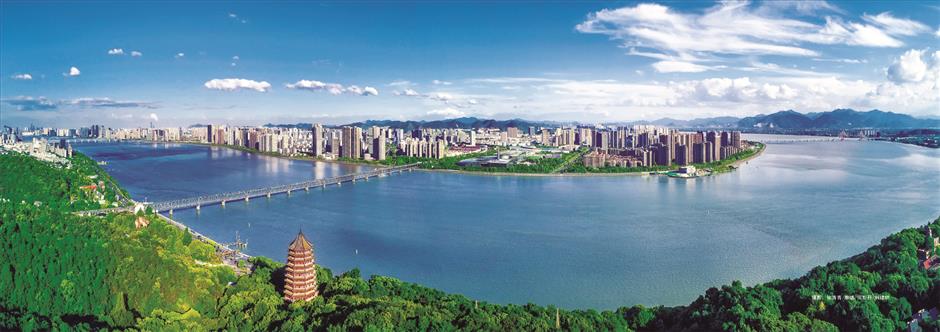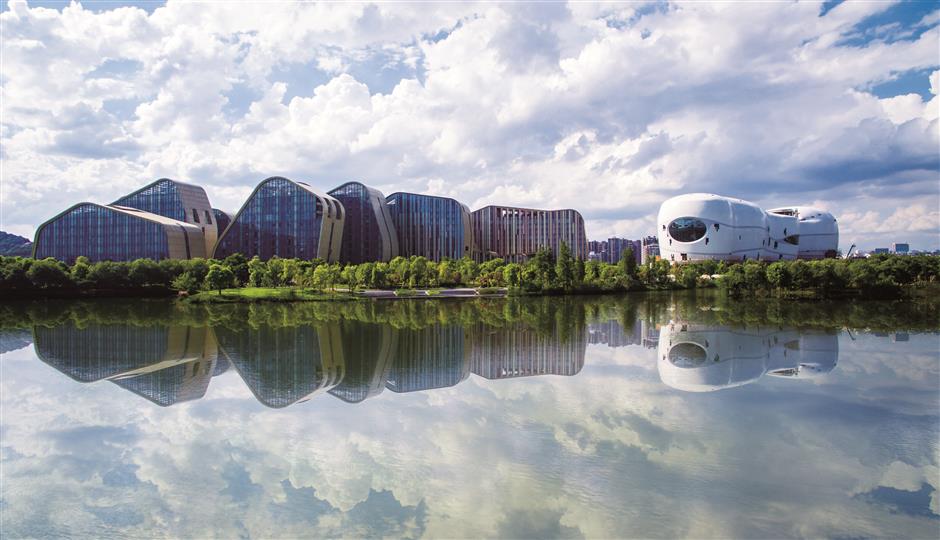Binjiang has a flowering ambition to grow

A bird’s-eye view of Binjiang District
Hangzhou’s Binjiang District is planning to become a district of flowers through greening thoroughfares, rivers, residential communities, preserved architecture and schools.
The 73-square-kilometer area along Qiantang River aims to be the equivalent of Singapore — Garden City — in Zhejiang Province, integrating a favorable environment with a developed economy.
First, greenbelts on roads will be planted with flowers and ornamental trees to suit the local climate. The government has invited professionals from local landscape design organization to design greening that varies with the seasons.
Every spring, the cherry blossom along the Wentao Road waterfront promenade is a favorite with visitors and considered a highlight of the annual Hangzhou International Marathon Competition by virtue of the majestic river view.
The promenade is popular with residents who stroll and jog along it every day. It has become a calling card of the district.
In addition to cherry blossom, Binjiang also boasts avenues dotted with ginkgo and crepe flowers. They are attractive to walkers and photographers when the vegetation changes color.
In April, pictures of Binjiang’s elevated roads showing their flourishing roses became an online sensation as online viewers were amazed by the district’s vista of flowers.
The local government is drawing experience from these routes and plans to construct more flowering paths to promote the cityscape.
“The tourism industry is the weak point of Binjiang. Flower-ornamented roads are hoping to be attractions,” said Lou Dongwen, director of Binjiang Urbanization and Landscape Office. “Sightseeing buses are planned to set along these roads in the future, with the aim of attracting tourists.”
The landscape construction is not only for tourism, however, but also to improve the living environment for residents.
The local government is going to build small gardens at residential blocks and street intersections. Every year, one to two gardens will be erected at these locations.
Every garden will have specific flower or tree species. Artificial plant walls, bonsai, flowerpots, climbers and balcony greening will be used to create exquisite nooks across the district. Sculptures will be erected to add an artistic touch, while benches will provide walkers with a place to rest.
As for unused space, the government will build temporary parking lots and greenbelts to avoid residents growing vegetables and dumping garbage. Inspectors are about to supervise these places and open up the greenbelts to the public.
The Wentao Road waterfront promenade is considered a highlight of the annual Hangzhou International Marathon Competition by virtue of the majestic river view.
A water-system landscape is also one of the highlights in the cityscape construction. Waterfront parks growing with willows, dawn redwood and peach trees are going to be built along rivers.
Binjiang is also taking advantage of the preserved buildings of the Zhijiang Cement Factory and turning the area into a park with leisure, education and industrial design functions. The project is hoped to be completed by the end of this year.
The factory was established in the 1970s and became a pillar enterprise in Hangzhou. However, it declined and finally shut down in the wave of industrial reform. Instead of pulling it down, Binjiang decided to preserve it as evidence of the urban changes over the past decades.
A large lawn, parking lot, square and footbridge will be built along with the park. It links with the cherry blossom promenade.
In addition, the district’s first park hidden in the hills — Guanshan Park — has finished the first phase of construction. Designers preserved the original mountain path and built it into a 2,000-step paved path for climbing.
The original vegetation and geological features were also preserved. Meanwhile, more than 5,000 trees and flowers have been planted to add more than 20,000 square meters of green area. The second phase of the project is currently under construction.

Baima Lake area
Xixing and Changhe historic streets are also included in the cityscape construction. Unlike noted Tangqi and Xiaohezhi streets that have already been revamped and developed into tourist attractions, Xixing and Changhe have maintained a low profile for years.
Xixing is the start point of the Eastern Zhejiang Canal, a section of the Beijing-Hangzhou Grand Canal. Due to lack of commercial development, the area still retains its original character.
Changhe is in a similar situation. It was established in the Five Dynasties and Ten Kingdoms Period (AD 907-979). The preserved buildings are the epitome of Ming Dynasty (1368-1644) style with engraved wooden rafters and beams.
Binjiang plans to revamp the two streets and their lanes, alleys, buildings and crisscrossed rivers. The government is engaged in numerous facelift projects, pulling down run-down homes and renovating the infrastructure.
After completion, Xixing and Changhe are expected to revive their past glory days and provide people with a new angle on Binjiang.
















